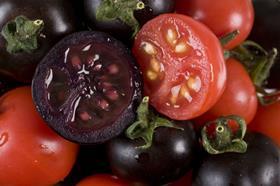
Genetically-modified purple tomatoes have moved a step closer to becoming a shop shelf reality.
The crop, developed by John Innes Centre (JIC) scientists in Norwich, UK, is currently being harvested in Ontario, Canada, for future research, and to attract interest from private investors.
The 5,000 sq ft glasshouse will yield enough tomatoes to produce 2,000 litres of purple tomato juice. This will then be used to generate new research and industry collaborations and to start the process of seeking the regulatory authorisation needed to bring a commercial juice to market.
Professor Cathie Martin, of JIC, said: “We want to explore a way for consumers to benefit from our discoveries, as we are finding there is a demand for the added health benefits.'
The colour of the tomatoes is derived from high levels of anthocyanins, compounds normally found in blueberries, blackberries and other deeply coloured berries.
The purple tomatoes have been shown to have anti-inflammatory effects compared to regular ones and to slow the progression of soft-tissue carcinoma in cancer-prone mice. They also have double the shelf life.
Paul Carver, CEO of New Energy Farms, where the tomatoes are being grown under glass, said: “The most amazing thing is the potential to supply an expensive compound from nature more economically to large markets for food, livestock feed, cosmetics, food colourings and even pharmaceuticals.'
The tomatoes and juice can be used to study the effects of a high anthocyanin diet on cancer, cardiovascular disease and other chronic diseases. Other varieties, high in compounds such as resveratrol normally found in red wine, are already being used to develop skin care products in collaboration with Essex company Biodeb.
Bringing the juice to the food market will require regulatory approval and may be possible in as little as two years in North America.



